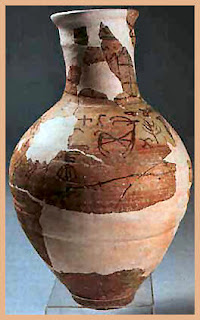The Ewer from Canaanite Lachish

For a short, helpful discussion of the famous Lachish Ewer, see the recent post on it at the Abnormal Interests blog (click here).
The inscription on the vessel, written in Proto-Canaanite, mentions a sheep offering for the Canaanite goddess Elat.
Who is the goddess "Elat"? It is interesting that the inscription on the ewer is written in such a way that the name of the goddess appears directly over the image of a stylized sacred-tree, a well known symbol of the fertility goddess Asherah. Elat may well be Asherah, the consort of El.
For the details of this argument and additional supporting evidence, click here, and take a look at a helpful WebPage discussion.

6 Comments:
Thanks for the link. I agree that Elat is most likely Asherah. I think the case can be made on epigraphic grounds alone. I don't think the iconographic evidence, while instructive, would be very convening without the epigraphic evidence.
I should have said "Asherah or ‘Ashtart."
Thanks Duane. ---Steve
Dear Steve,
I suggest you a little more caution in identifying the stylized sacred tree with Asherah (see my lemma Asherah in the IDD project http://www.religionswissenschaft.unizh.ch/idd/prepublication.php).
Further, in Ugaritic "Elat" (i.e. ilt) can also be an epithet of Anat (KTU 1.50:2-4) or Astarte (KTU 1.112:25) or also a common noun meaning goddess (KTU 1.39:11) See D. Pardee, Les textes rituels, Paris, vol. 1, 2000, p. 181-182.
If you can read Italian, please see my article on Asherah iconography published in SEL 1997 and available on line at
http://www.ieiop.com/publicaciones/listado.php?idcategoria=28.
Last but not least, I think Asherah is not a "fertility goddess", as in the Ugaritic texts Atirat does not appear to be connected with fertility, but only with divine (or royal) motherhood. The "mother of the gods" is not a fertility "mother goddess" (S.A. Wiggins, A Reassesment of Asherah, Muenster 1993, p. 70-71)
Best wishes,
Paolo Merlo
Hi Paolo, Thanks so much for these links and references. I'm very glad to have them as part of this post. The IDD project looks to be a great resource, and I should give it a separate post when I have a chance. I have just looked over your article there at the IDD site, and congratulate you for it. An intense study of the topic is not possible for me right now (this month, at least). Can you tell us if there is evidence associating either Anat or Ashtart with the sacred tree? As you say in your article, we can at least be confident that in Bible Asherah is somehow tree-like. Thanks, ---S.
Dear Steve,
I remember no iconographic association between sacred tree and Ashtart or Anat. I will have a look at the monograph of I. Cornelius, The Many Faces of the Goddess, 2004 (OBO 204).
Best wishes, Paolo
Post a Comment
<< Home